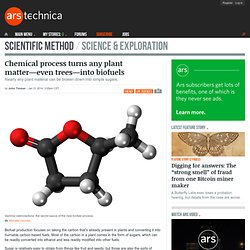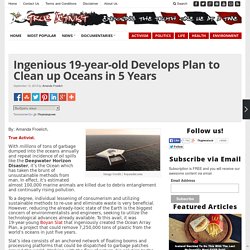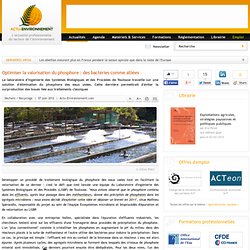

Regulating Mass Surveillance as Privacy Pollution: Learning from Environmental Impact Statements by A. Michael Froomkin. US law has remarkably little to say about mass surveillance in public, a failure which has allowed the surveillance to grow at an alarming rate -- a rate that is only set to increase.

This article proposes 'Privacy Impact Notices' (PINS) -- modeled on Environmental Impact Statements -- as an initial solution to this problem. Data collection in public (and in the home via public spaces) resembles an externality imposed on the person whose privacy is reduced involuntarily; it can also be seen as a market failure caused by an information asymmetry. Current doctrinal legal tools available to respond to the deployment of mass surveillance technologies are limited and inadequate. Chemical process turns any plant matter—even trees—into biofuels. Biofuel production focuses on taking the carbon that's already present in plants and converting it into burnable carbon-based fuels.

Most of the carbon in a plant comes in the form of sugars, which can be readily converted into ethanol and less readily modified into other fuels. Sugar is relatively easy to obtain from things like fruit and seeds, but those are also the sorts of things we like to eat. Most of the sugar in the rest of a plant, however, is locked into a complex polymer called cellulose. Figuring out a way to easily break down cellulose has been one of the major hurdles to the expansion of biofuels.
Now, researchers from the University of Wisconsin–Madison have figured out a chemical treatment that, given a bit of time, can completely dissolve any plant matter including wood. The key ingredient in the chemical treatment is gamma-valerolactone, a ring-shaped molecule that incorporates an oxygen in its ring. Using iron to clean steelmaking, a very dirty business.
Iron and steel are components of an almost limitless number of infrastructure and consumer goods.

From forks to tanks, syringes to satellites, cars to computers, from buildings to the power stations that electrify them, around 1.4 billion tonnes of steel is made each year. But manufacturing iron and steel is an energy intensive process that demands huge amounts of power and heat to reach the high temperatures required for smelting and shaping the metal. This means burning considerable amounts of fossil fuels, which in turn generates huge amounts of carbon dioxide and other greenhouse gases. It is a dirty business, which makes the need for a means to clean it up all the more pressing.
Current methods used to remove CO2 from exhaust gases require expensive “scrubbers” using caustic chemical solvents such as monoethanolamine (MEA). A dirty business Producing steel from iron ore involves two stages. About 70% of the overall carbon cost is consumed just in making the iron alone. La carte mondiale de l’utilisation des sols. Must-See Chart: Cost Of PV Cells Has Dropped An Amazing 99% Since 1977, Bringing Solar Power To Grid Parity. By Joe Romm "Must-See Chart: Cost Of PV Cells Has Dropped An Amazing 99% Since 1977, Bringing Solar Power To Grid Parity" The price of solar photovoltaic cells has dropped 99% in the past quarter century.

So in an increasing number of markets around the country, solar is at or very close to grid parity. Consider Colorado. En Ecosse, le lancement du plus grand parc d'hydroliennes d'Europe. Pourquoi le réchauffement climatique est-il en veilleuse depuis 15 ans? Vendredi 27 septembre à 10 heures à Stockholm, une conférence de presse annoncera les résultats du groupe de travail n°1 du Groupe intergouvernemental sur l’évolution du climat (Giec).

Auparavant, du 23 au 26 septembre, 209 contributeurs et 50 relecteurs provenant de 39 pays plancheront sur les 600 contributions émanant de 32 pays. Pendant cinq jours, ils traqueront les erreurs qui auraient pu leur échapper lors de l’écriture du projet de rapport. Au final, ils publieront vendredi le rapport final et la fameuse synthèse pour les décideurs, autrement dit un résumé pédagogique pour les non spécialistes. publicité Les fuites se multiplient Ce rapport de 127 pages constituera le chapitre scientifique du cinquième rapport du Giec, dont l’intégralité sera publiée en octobre 2014, soit sept ans après le quatrième rapport de 2007.
On peut donc être sûrs, d’ores et déjà, qu’aucune remise en cause des conclusions précédentes du Giec n’est à l’ordre du jour. The Ocean Cleanup - Boyan Slat. In 2011, together with friend Tan Nguyen, Boyan Slat embarked on writing his final paper in the last year of secondary education, researching the possibility of remediation world’s oceanic garbage patches. During this project, they performed analyses on concentration of particles between 90 micron and 333 micron, plastic/plankton separation, plastic depth measurement devices and amount of plastic within the top layer of the gyres. Spending over 500 hours on the paper (instead of the required 80 hours), it has won several final paper prizes, including Best Technical Design 2012 at the Delft University of Technology. Boyan continued the development of his concept during the summer of 2012, and revealed it several months later at TEDxDelft 2012. At iSea Clash of The Concepts, The Ocean Cleanup was awarded the second prize by the Dutch Ministry of Infrastructure and the Environment.
Boyan Slat. Ingenious 19-year-old Develops Plan to Clean up Oceans in 5 Years. Image Credit / boyanslat.com By: Amanda Froelich, True Activist.

With millions of tons of garbage dumped into the oceans annually and repeat incidence of oil spills like the Deepwater Horizon Disaster, it’s the Ocean which has taken the brunt of unsustainable methods from man. In effect, it’s estimated almost 100,000 marine animals are killed due to debris entanglement and continually rising pollution. Pubs.rsc.org/en/content/articlepdf/2013/ee/c3ee41973h. Sometimes storing electricity makes no (energetic) sense. Two of the major renewable energy sources, wind and solar power, are intermittent in that they can't always be relied on for power.

Although there are many strategies for mitigating the impact of the interruptions, the intermittency is thought to place a limit on the percentage of renewable power that can be easily integrated into the electric grid (although the precise point at which it becomes a problem is a bit of a moving target). Optimiser la valorisation du phosphore : des bactéries comme alliées. Le laboratoire d'Ingénierie des Systèmes Biologiques et des Procédés de Toulouse travaille sur une solution d'élimination du phosphore des eaux usées.

Création d'un pôle dédié à l'identification des micro-algues toxiques. L'Ifremer a annoncé le 1er juin 2012 le rapprochement des moyens humains et des compétences de son laboratoire Environnement ressources de Concarneau et de la Station de biologie marine du Muséum national d'Histoire naturelle de Concarneau, ainsi que l'acquisition et la mutualisation d'équipements.

New Energy Architecture, Enabling an Effective Transition. This report notes that the shift to a new energy architecture to secure sustainable and affordable energy will entail trade-offs and difficult choices for policy makers and society.

It also notes that the path countries take to transform their energy architecture will have some common features—lean, low-carbon and increasingly electrified systems—but will vary according to their stage of economic development and their resource endowment. To help decision makers in planning and driving an effective transition and to assess their progress, Accenture and the World Economic Forum have developed an Energy Architecture Performance Index (EAPI). One hundred and twenty four countries were assessed across three dimensions: economic growth and development, environmental security and energy access and security, which revealed that much more needs to be done to accelerate the transition to meet future demands.
Www.developpement-durable.gouv.fr/IMG/pdf/Indicateurs_FR.pdf. Www.actu-environnement.com/media/pdf/news-15545_Blum_Roland_rapport_energie_v6.pdf. Www.accenture.com/SiteCollectionDocuments/PDF/Accenture-Procurement-Beyond-Price-Petroleum-Review-March-2012.pdf#zoom=50. Jonathan Foley: The other inconvenient truth. Scientific Support for the Transition to a Low Carbon Economy - News & events - JRC. Copenhagen (DK) - 06/03/12 Science is the basis of international climate policy. In the fight against climate change, both at international and domestic levels, the development and deployment of low carbon technologies play a critical role. More research is needed to understand the atmospheric system and its interaction with human activities. Scientific support is key to stimulate and catalyze technological and business opportunities in the transition to a low carbon economy. The Copenhagen Accord of 2009 has recognised the scientific view that to combat climate change the increase in global temperature should be below 2 degrees Celsius compared to pre-industrial levels.
The conference Scientific Support for the Transition to a Low Carbon Economy on 6 March 2012 will provide a forum for discussions on how scientific advice can best contribute to robust policy frameworks. Venue Radisson Blu Royal Hotel, Hammerichsgade 1, 1611 Copenhagen V. Www.sei-international.org/mediamanager/documents/Publications/Climate-mitigation-adaptation/sei-report-2012-3c-biomass.pdf.
Sustainability. Energy.